2/01/2005
Bahati 060301
Bahati Haiku Poetry Club
Meeting in March 2006
Caterpillars
-----------------
moving cylinder
whole amour of black arrows
all over the body
an eyeless insect
wriggling on vegetation
leaves disappear
green black and brown
moving in the grass and house
touching it is trouble
long black and hairy
always ready with amoury
one-insect-army
a bird swoops down
picking a caterpillar
on a leaf
a hen pecks
a caterpillar on its beak
the hen is satisfied
hairy insects
hiding in dark places
people clean their houses
evening comes
villagers shake their beddings
they are scared
children play
in the tall grasses
screams are heard
in the village
a woman jumps and screams
tearing off her clothes
in the village
a man pulls down his trousers
he screams
Patrick Wafula
they creep along
on their cylindrical bodies
eating every green
Nicholas Kasyoki
cloudless sky
caterpillar destinates
under withered crops
Cyprian Awino
hairy as they are
they burrow in the soil
aerating the soil
today they are hairy
soon they turn into butterflies
children play with them
Catherine Njeri
hairy insects
scattered on the leaves
destroy our plants
after a short while
beautiful butterflies
come out of them
small hairy worms
silently crawling over the land
soon comes the rain
Felix Munyao
small creatures
vegetables disappear
when you appear
Justin
it strolls along
digging holes in shambas
soon the rain falls
Depporah Mocheche
New school year
----------------------
prefects at work
everyone obeys
making the environment clean
the bell goes
everyone in hurry
do not be late
lesson after lesson
teacher after teacher
the timetable is followed
the bell goes
games and sports
everybody warms up
smiling faces
students with new bags
new books
Felix Munyao
eyes on the board
books and pens on tables
brains at work
bells ring
children run
school gates open
bags on shoulders
books and pens in hand
it is school time
Francis Ouma
the bell goes
monos move with their parents
they gather in the office
Jeremiah Osewe
nyithindo mor
somo and writing on books
as a teacher guides
Walter Ochola
new year
new faces join high school
form one
school year
students carry bagfuls of books
to and from school
a school fees burden
parents struggle to pay
principal is harsh
Jasper Ratemo
hurrah! hurrah!
welcome new faces
call them monos
Linet Anyango
Idd-ul-Fitr
---------------
sweet aroma of rice
kanzus and buibuis
allah akbar
Cyprian Awino
Mourning
-------------
dark hour has come
the dirge slows down
all fight back tears
Cyprian Awino
African Night
------------------
the floor of heaven
carpeted with bright stars
yellow balls
Cyprian Awino
Sunrise
------------
cool breeze blows
the mist evaporates
sparkling rays glow
Cyprian Awino
Funeral
-------------
wails and wui
drums beat horns blow
all over the village
Daniel Awino
Water Shortage
---------------------
water scarcity
jembes take advantage to rest
pots totally dry
Lameck Odhiambo
Plums
---------
a woman
with child on her back
buying plums
Walter Oochola
cracked soil
women bend up and down
selling plums and mangoes
Depporah Mocheche
Wind
---------
calm trees shake
dry leaves and dust fly up
calm sea stirs
Raymond Otieno
feeble things go up
clothes ripple on hang lines
roofs creak
Cyprian Awino
Dust
--------
red dust on roads
brown grass on women's dresses
women carry cans
Depporah Mocheche
Circumcision
-------------------
december comes
all the people all over Kisiiland
sing and dance nyamocheche
Depporah Mocheche
Famine
-----------
empty stomachs
stains of tears on cheeks
clean utensils
Cyprian Awino
Sunny season
--------------------
sunny midday
coats loose their value
sweat streams down
Cyprian Awino
Drought
---------------
rain goes on strike
cassava on high demand
kwashiorkor rises
Cyprian Awino
AIDS
----------
coughing all over
many skeletal people
hospital beds full
Patrick Wafula
Long Rains
---------------
fat healthy cattle
green leaves on thick branches
grass nature's carpet
Cyprian Awino
Mango
-----------
We fold our tongues and suck
Sweet yellow juice
Between out teeth we grind
Tasty yellow flesh
Our fingers we lick
The sweet smell
Cyprian Awino
*****************************
Related words
***** Bahati Haiku Poetry Club, Kenya
***** BAHATI HAIKU POETRY CLUB, Records of all Haiku Collections
***** Caterpillar, Hairy Caterpillar
***** Ramadan ends (Idd ul Fitr)
***** Start of new school year
***** Water shortage , drought
***** World AIDS Day
***** Mango fruit
*****************************
THE KENYA SAIJIKI
Please send your contributions to
Gabi Greve / Isabelle Prondzynski
worldkigo .....
Back to the WHC Worldkigo Index
Bahati Greetings
:::::::::::::::::::::::::::::::::::::::::::::::::::::::::::::::::::::::::::::::::::::::::::::::::::::
Greetings for the Ginko in Keyole
Greetings from Dr Gabi Greve, Director of WHC World Kigo
Nairobi, 27 May 2006
--------------------------------------------------
Greeting at the start of the Ginkoo
-------------------------------
Dear Haiku friends in Kenya,
finally the great day of your first big Ginkoo, the Haiku walk, has come ! You must be so excited to be on your way, so just a short word of advice:
You will all walk through the same area, so try and see the small details around you, like looking through a microscope. Then your haiku will reflect many facets of this area. Your haiku will then show YOUR very own part of it and will definitely be unique. Even if 200 people walk around in the same place, you might find in the end that each one of you has his or her very special way of seeing and experiencing things.
When Isabelle san visited me in April, we talked a lot about this meeting and I am really sorry not to be with you today. But I gave her a small present for the three best haiku which will be selected today, so try hard !
A great thank you to all who helped prepare this day !
Now be on your way with all the best wishes from your Haiku friends worldwide.
Gabi from Japan
in the name of the World Kigo Database
Greeting at the Prize Giving
--------------------------
Dear friends, your day has come to an end and all haiku are now written and evaluated.
My most heartfelt best wishes to the winners of today's Haiku Meeting ! I hope you all learned a bit more about haiku and will continue to enjoy writing haiku.
Isabelle san will now hand you the three little presents. They are little notebooks to write haiku in, especially for Japanese of course, so you can enjoy looking at these small strange Japanese
characters. Maybe one day, through your continuous study of Haiku, you will even be able to read them !
As you will see, the lines are from top to bottom, in the typical way of writing Japanese !
To use them, you will have to turn the notebook to write in your way !
There are so many different things done differently in other cultures, but through haiku you can learn about many in a pleasant way !
I wish you all the best for your future events !
Gabi from Japan
:::::::::::::::::::::::::::::::::::::::::::::::::::::::::::::::::::::::::::::::::::::::::::::::::::::
Greeting from Sakuo Nakamura to the Nairobi Ginkoo
27 May 2007
-----------------------------------------------
Dear Kenya boys and girls
I am a Japanese, living in Tokyo.
I like to paint pictures, and my work refers to the following story.
Three years ago my old sister has asked me to paint a picture. She was old and ill in bed for some time. Once she was very beautiful and received many love letters.
In my boyhood she was my flower of pride.
I decided to present her my Haiku with a picture. For encouraging her, I painted cherry blossoms and added a short haiku poem.
hana nari shi kimi iki iki to haru goto ni
The English translation means
once like a flower
you refresh
every spring

At first I made this poem in Japanese and translated it to English. This was my first experience to make Haiku.
After that, I have been trying to make haiku with English and Japanese. In those processes, I found that I could start thinking haiku by both languages that finally reach at a single concept.
Haiku consists of few words so that each word of every language should have the same meaning.
This is why I recommend you to make haiku in the language of yours and English, and maybe later in Japanese. The practice will help you to learn foreign languages.
There is one difficult point in bilingual haiku. The point comes from the gap of culture. There are two types of gaps.
One belongs to space, that is between countries.
Your mountain is perhaps red in color but mine are green.
You have a wide desert. We are surrounded by sea.
The other gap is time, for example, that is between myself and the Japanese haiku poet Issa who lived 200 years ago in Japan. I drink coffee now but Issa did not know coffee.
How do you get over those gaps of time and space ?
One assistance is by pictures or photos that bring the image to your mind. So I paint haiga (haiku with an attached picture) in my BLOG called "Everyday Issa".
Issa is one of famous haiku poet in Japan. You can meet him in Dr. David's site on the Internet.
http://haikuguy.com/issa/
http://sakuo3903.blogspot.com
Issa, David and I, Sakuo are flying to anywhere in the world. We three can go anywhere by internet. Through the internet the whole world can get in unison physically, but really we are struggling with each other.
Let's learn haiku to deepen our mutual understanding. Therefore peace comes true.
Sakuo Nakamura in Tokyo
*****************************
Back to the Ginko in Kayole
BACK: Kayole, 27 May 2006
[ . BACK to WORLDKIGO . TOP . ]
:::::::::::::::::::::::::::::::::::::::::::::::::::::::::::::::::::::::::::::::::::::::::::::::::::::
BAHATI 060418
Bahati Haiku Poetry Club
April 2006
Fresh green kales
Shining at the bright glint
Starvation is gone
Large round pears
Everyone sucks on them
As we dash or doze
Gumboots on legs
umbrellas in hand
grump croaks from frogs
Sprouting green grass
Dew-wetted leaves
A morning breeze
A cold chill at night
Beneath woolen blankets
The crickets chirp
Water-borne diseases
Students’ thinking capacity low
Systematic sneezes
Catherine Njeri
ooo ooo ooo ooo ooo ooo ooo ooo
Dark lowly clouds
showers of raindrops
flooding earth surface
Heavy rain drops
hitting earth’s floor forcefully
rivers and lakes filled
Mud everywhere
Gumboots on everyone’ legs
Cold breeze blows across
Running everywhere
Sharp heavy drops of rain
Water overflows
Grey cloud cover
Colourless drops of rain
Withered crops rise again
Jembes on shoulders
On the way to the shambas
Waited rain drops
………. *jembe * a hoe.
Strange birds fly up
Frogs crock butterflies fly
Black ants emerge
Umbrellas spread high
Heavy drops land on them
A man shivers hard
Blue gurgling river
Water lilies sprout
Dragon flies fly round
Green grasshoppers
Long nappier grass all over
Cattle grow fatter
Farmers toil
Weeds all over the shambas
Rabbits celebrate
Sweet scented flowers
Colorful butterflies
Peppergrass sprouts
Cyprian Awino
ooo ooo ooo ooo ooo ooo ooo ooo
Garisa downpour
Animals sniff and lick the water
Kids splash on mud
A helicopter over head
Flooded residence
people flee to high ground
Open umbrellas
Pedestrians dashing along
Puddles on the streets
Sound of water dropping on roofs
Colorful reflections of streetlights
On the wet pavements
A foggy Marsabit
A plane disappears
Government mourns
Coffins out of the plane
Pallbearers with open umbrellas
Moyale burial
Raymond Atieno
ooo ooo ooo ooo ooo ooo ooo ooo
EXAMS
Start stop time on the board
White papers in front of them
Teachers watch by
Raymond Atieno Form 2E
Muddy shoes
Tidiness first priority
A queue at the water tap
Catherine Njeri F2
He is back again
Patrick Sensei with his camera
Chasing after insects
Catherine Njeri F2
ooo ooo ooo ooo ooo ooo ooo ooo
FREE HAIKU
Catch and hold it
The Sensei shouts to members
Nature cherishes the soul
Stuck vehicles
Wherever the journey ends
Agitated drivers
Flags half mast
Kenya is mourning
A peace making decree
A terrible plane crash
A county’s shock
Lamentations all over
Bent backs
Sweat trickles
As women toil
Blooming flowers
The river gurgles
Sweeping crops
White shiny butterflies
Silent grasshoppers
Strolling over the wet grass
Happy Easter
All clad in glamour
A holiday for all
Kilifi Nematode
Firmly stuck to the ground
It is fresh and strong
Catherine Njeri F2
ooo ooo ooo ooo ooo ooo ooo ooo
Sweep glances on sky
Gibbous moon in control
Scattered stars glitter
Cyprian Awino F3
*****************************
Related LINKs
***** Bahati Haiku Poetry Club, Kenya
***** Bahati Haiku Poetry Club, Record of all Haiku Collections
*****************************
THE KENYA SAIJIKI
Please send your contributions to
Gabi Greve / Isabelle Prondzynski
worldkigo .....
Back to the WHC Worldkigo Index
Bahati 060527
Ginkoo in Kayole, Nairobi (Kenya)
Bahati Community Secondary School, 27 May 2006
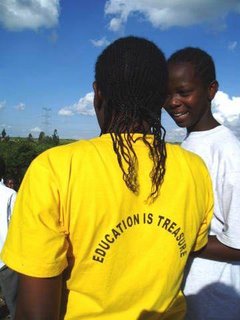
Education is Treasure
On 9 January 2006, when the Bahati Haiku Poetry Club (nickname : The Bamboochas) was born, the members were immediately eager to advance and progress in haiku themselves, and to do this together with their colleagues in neighbouring schools. That very first day, the idea was born to host a Ginkoo (吟行) in May 2006 and to invite other schools to participate.
During the following weeks, the Bamboochas studied and practised haiku under their teacher, Patrick Wafula (Patrick Sensei) and enjoyed themselves thoroughly -- as their name implies. Once they reached the mid-term break, they set out to present the art of haiku to the neighbouring schools, all of which liked the idea and decided to set up their own haiku clubs :
Embakazi Secondary School - The Oaks
Brookfield Secondary School - The Spiders
St Matthew’s Secondary School - The Peacocks
Lorna Waddington High School - The Falcons
Each of these clubs chose a patron among the teachers and started writing haiku. During April and May 2006, they organised a series of mini-ginkoo, one by one, and invited representatives of the other haiku clubs to join them.
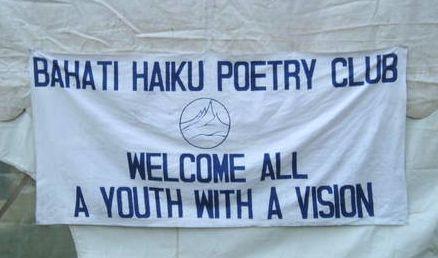
Photo 1 : Welcome sign at the Bahati tent.
They also made contact with the Japan Information & Culture Centre of the Embassy of Japan in Kenya and invited the Director, Mr Shinya Machida, to be Guest of Honour at the forthcoming Ginkoo. Mr Kiruri Gachie of the Japanese Department, Kenyatta University, was also invited, as were the Japanese community members resident in Kenya.
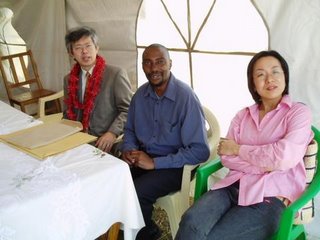
Photo 2 : Mr Shinyo Machida (Director of the Japan Information and Culture Centre), Mr Kiruri Gachie (Japanese Department of Kenyatta University), Ms Yooko Enomoto (Co-ordinator of the Japanese Association of Kenya).
A committee was formed in the local community, to take charge of the organisation and planning for the ginkoo, and the scouts were mobilised to contribute to the occasion. Almost 250 participants and guests were invited, including the local Chief and Sub District Officer as well as the Officer in Charge of the Police Post.
Finally, the day dawned to warm sunshine and great activity at Bahati School, as the tent was erected in front of the building and the haiku club members arrived in very good time, paper and pen in hand. Soon, many of the students were going through final rehearsals for their presentations, planned for the afternoon. I too was there early, enjoying the festive mood and the anticipation keenly felt by all.
xxxxxxxxxxxxxxxxxxxxxxxxxxxxx
The gathering started soon after 11.00 hrs, with the Kenyan and Japanese flags raised together by the Kenya Scouts, and the Kenyan National Anthem sung.
Photo 3 : Kenya and Japanese flags being raised by the Kenya Scouts
(Unfortunately we can not add all the photos here. Please click on the LINK to see the photos in the Bahati Club Photo Album. )
The Patrons introduced their respective haiku clubs -- and we finally heard why they had chosen their meaningful nicknames :
the Peacocks for the instant readiness of the bird, as well as its beauty,
the Oaks for the strength and durability of the tree,
the Falcons for the keen vision of the bird,
and the Bamboochas for the refreshment which their haiku would bring.
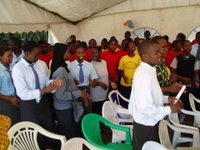
Photo 4 : The haiku clubs ready for action
There was a lot of cheering. Everyone was happy to be there, and to join with the members of the other clubs -- they had already become friends through sharing in the mini-ginkoo. This was the first time that the four schools had come together for an event, the first time that Bahati had hosted an event for the wider community, the first haiku ginkoo ever in Kenya (as far as we know!) -- and we even believe it may have been the biggest haiku event in the world on 27 May 2006. There was great joy in Bahati!
Photo 5 : Eager Falcons listening to the opening speeches
xxxxxxxxxxxxxxxxxxxxxxxxxxxxx
Mr Machida spoke to the gathering about the tradition of haiku in Japan, the history underlying it, and how it had continued into the present day, since it was grounded in the seasons and in nature. Even as it moved beyond Japan and into new territories, it was this link with nature and the seasons which made it adaptable to any culture and any country. Mr Machida was happy to see this first blossoming of haiku in Kenya, and wished the haiku clubs every success as they continued to learn and to practise.
As the Moderator of Kenya Saijiki, I then sent the students out to start their ginkoo. Observe keenly, and write no more than three haiku. The kigo (if used) could be from either the long rains, or from the cool dry season, as we were right between the two. The students then set out and, very soon, they had scattered in a 500 m radius around the school, heading off in different directions, often in small groups.
Bahati School is situated right next to Kayole River, which at this time was showing the effects of the long rains, with a lot of rubbish (including signs of sewage) washed up on the banks around the school. Several students devoted their attention to the river and its banks, all observing different aspects and drawing different conclusions. Thus, some of the poets observed the dirt and the smell, while others noticed how the deposits were helping nearby maize and bananas to grow!
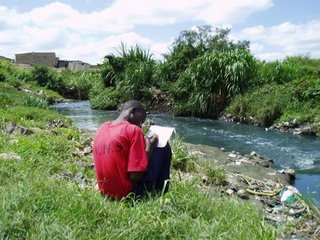
Photo 6 : Falcon deeply focused on Kayole River
xxxxxxxxxxxxxxxxxxxxxxxxxxxxx
After an hour, the students returned, and there was great excitement and a feeling of achievement. Everyone then selected their very best haiku of the day, writing it on a piece of colourful origami paper, and handing it over to the jury. Names were not included, only the haiku clubs were identified.
Photo 7 : Haiku submissions
While the jury retired to the cool courtyard of the school, the haiku clubs entertained the guests with lively presentations of poetry and drama, which they had rehearsed for the event. Sodas were enjoyed, bread and biscuits consumed, and much fun was had by all, while anticipation mounted.
Photo 8 : The jury in action
The jury needed quite some time to reach its conclusions on the winners -- luckily, we had a cool space within the school, where we deliberated and grouped the individual haiku entries with weights of water bottles, stones, spectacles and anything else that came to hand!
xxxxxxxxxxxxxxxxxxxxxxxxxxxxx
Before starting on the prize giving as such, Kiruri Gachie congratulated all the young poets on their work and the beautiful haiku they had written, and encouraged them to keep learning and practising. Being in touch with Kenya Saijiki and Worldkigo by internet would help them to exchange with poets in other countries, as well as learning from today’s masters.
The prize giving started with places 11 to 18 (in no particular order), followed by places 4 to 10 (again, in no particular order, with each poet receiving a Japanese cup). Then, the winners so far posed for a photograph :

Photo 9 : The winners of places 4 to 18
Finally, special prizes to the winners of places 3, 2 and 1 : a haiku notebook from Japan sent by Dr Gabi Greve, the Director of the World Haiku Club’s Worldkigo. A book or a painting went to each of the top three, as well as a Japanese cup and a book on Japan from Mr Machida. The winner of the first prize received a beautiful Ikebana calendar from the "Japanese Cultural Centre".
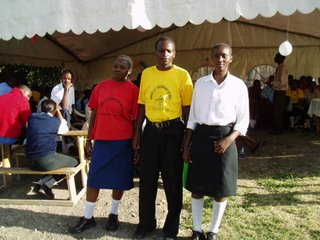
Photo 10 : The first three prizewinners, Grace Wanjau, Oseme Jeremiah and Miriam Nyambura
The atmosphere was wonderful -- more words of thanks were conveyed and received, and no one wanted to leave. Conversations continued, more photos were taken, but finally, the tent was dismantled and the students went home. There will certainly be more events -- the next one will most likely be a learning event, hosted by the Japanese Cultural Centre.
It was a beautiful day, and an unforgettable memory for most of us. The good wishes of Kenya Saijiki and Worldkigo were passed on and savoured, and we enjoyed being part of a world wide movement and being upheld by world wide good wishes.
Congratulations to everyone -- Bamboochas, Falcons, Oaks and Peacocks, as well as the organising committee -- and we look forward to welcoming the Spiders with us next time!
Isabelle Prondzynski
!!! Please click here to read the greetings from Gabi Greve and Sakuo Nakamura !!!
. Read short biographies of the winners of this contest .
*****************************
HAIKU
The prize winning haiku were as follows :
(Japanese by Nakamura Sakuo)
1.
strong and healthy maize
due to sewage nutrients --
very green colour
-- Grace Wanjau (Falcons)
唐黍や汚水で育つ青々と
tookibi ya osui de sodatsu aoao to
Photo 11 : Haiku student observing Kayole River
2.
a green insect
crawling in green grasses
sucking green sap
-- Oseme Jeremiah (Bamboochas)
青虫や 青葉を這って 青汁チュウ
aomushi ya aoba o hatte aojiru chu~
3.
goats and cows
scattered all over the place
grazing up and down
-- Miriam Nyambura (Bamboochas)
山羊羊 散りて草食み 上下へ
yagi to ushi chirite kusa hami ue shita e
4. - 10. (in alphabetical order of author name)
happy looking child
eats fleshy avocado --
no hunger at last
-- Cyprian Awino (Bamboochas)
幸せな 子 アボガド食べる 飢えは無し
shiawase na ko abocado taberu ue wa nashi
along the river bank
always green butterflies pounce
happily on cool grass
-- Gideon Gichamba (Peacocks)
cool, calm afternoon --
group of students crouch over
the grass for a bed
-- Kennedy Odhiambo (Bamboochas)
steps up and down
up the hills down the valleys
trying to observe
-- Olande E. Nancy (Oaks)
Photo 12 : Haiku students observing and writing
young African girl
looking confused
cutting kales
-- Ouko Hellen (Falcons)
rain has ended
footprints remain dry on the paths
kids stumble and fall
-- Raymond Otieno (Bamboochas)
Photo 13 : Children stuck in a dried rut (picture taken same day)
Kayole river
flooded with sewage
ugh! bad odour
-- Samuel Mwangi (Falcons)
11. - 18. (in alphabetical order of author name)
coloured petals
sprung like mushrooms
Njeri get decoration
-- Bonface Mutua (Falcons)
green turns to grey
crops mature as plants shed
as sun shines
-- David Wandera (Bamboochas)
dried up lips
thirsty throats in hotels
babies barefooted
-- Deborah Mocheche (Bamboochas)
bidens pilosa
growing taller and taller
shining everywhere
-- Felix Muyao (Bamboochas)
under the shade
people are squeezed
loosening their clothes
-- Lameck Odhiambo (Bamboochas)
"ten, ten, jeans!"
a man selling pants
they are so big
-- Mercy Keago (Falcons)
dust on shoes
as people walk down and up
along Soweto slum
-- Sammy Opagala (Bamboochas)
healthy bananas
using sewage manure --
very attractive
-- Samson Munga (Falcons)

Photo 14 : Closing the Ginkoo
*****************************
Related Entries
***** Bahati Haiku Poetry Club
BAHATI HAIKU POETRY CLUB, Records of all Haiku Collections
Look at the Bahati Haiku Poetry Club Photo Album
*****************************
THE KENYA SAIJIKI
Please send your contributions to
Gabi Greve / Isabelle Prondzynski
worldkigo .....
Back to the WHC Worldkigo Index
Bahati 0601
Bahati Haiku Poetry Club
First Meeting January 2006
Night fall-
The crickets sing
The owls hoot
Patrick
Night fall-
Chickens come to roost
The dogs bark
Patrick
Breaking dawn-
Birds chirp merrily
The cocks crow
Patrick
........................................... Drought
Severe drought
Withered crops on farms
Dry riverbeds
Maxmilla
Austere drought
Withered grasses and trees
Carcasses all over
Catherine
Severe drought
Empty granaries
Children cry
Sammy
Austere drought
Deserted manyattas
Animal carcasses
Patrick
Long drought
Clanking jerricans
Empty tanks
Maxmilla
Terrible drought
Long queues at water tanks
Women carry jerricans
Raymond
The hot sun scorches
The earth is dry and parched
People take shelter
Rehema
Dry whirlwinds blow
Maasais and their cattle flee
Carcasses and stench
Teresia
............................... Christmas Season
Christmas season
Children sing carols
The church bells toll
Frank
Christmas season
Disco lights twinkle
Drizzles trickle
Patrick
Merry Christmas
Men drink busaa
Women ululate
Patrick
Happy Christmas-
Drunkards stagger
Children sing
Catherine
Merry Christmas-
Women sing mwanambeli
Litungu plays
Patrick
Christmas season-
Youths clad in glamour
Dance mugithi
Patrick
........................................... Africa
The African sun-
Animals stroll side by side
Hakuna matata
Safari
Harusi ya fahari-
Women in buibui men in clocks
Allahamuddulahi
Safari
Harambee-
Pull push a working nation
Wakenya muko?
Safari
Tujienjoy Christmas
Siasa mchezo mchafu
Bado mapambano
Safari
The Referendum-
Oranges-bananas tawe eeh
Confused Kenyans
Safari
Alluta continua-
Jua kali hammers taa taa
Wacha kuregarega
Patrick
Matatu madness-
Ever so early and so fast
But everyone is late
Patrick
Wanjiku-
Huyo bure pumbavu
Constitution
Safari
Mugithi-
The train passes on and on
Children pass
Safari
............................... The Long Rains
The long rains-
The fisherman´s wife
Grows plumper
Patrick
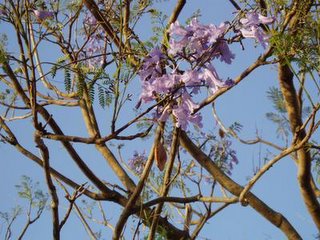
Photo Isabelle Prondzynski
The long rains-
The jacaranda tree
Blooms purple
Patrick
The long rains-
Sunbirds suck flower juice
Weaverbirds make nests
Patrick
The long rains
The grass is greener and taller
Cattle grows fatter
Patrick
The long rains
Farmers stoop over their farms
Striking with their hoes
Patrick
The long rains
The sky is darker
People rush indoors
Catherine
The long rains
Lightning flashes
Thunder rumbles
Patrick
The long rains-
Umbrella hawkers
Jam the streets
Patrick
The long rains
Muddy water-filled streets
Squelching shoes
Patrick
The long rains-
The herrings swim happily
The eels multiply
Patrick
The long rains
The shoeshiner´s pocket
Grows bigger
Patrick
Rainy season-
Bright coloured butterflies
Flap their wings
Patrick
*****************************
LINKS
***** Bahati Haiku Poetry Club, Kenya
***** Bahati Haiku Poetry Club, Record of all Haiku Collections
..... Continue to the Second Haiku Meeting .....
*****************************
THE KENYA SAIJIKI
Please send your contributions to
Gabi Greve / Isabelle Prondzynski
worldkigo .....
Back to the WHC Worldkigo Index
Bahati 060204
Bahati Haiku Poetry Club
Third Meeting February 2006
Subject: NEW SCHOOL YEAR
bells ring
it is school year
all over Kenya
Francis Ouma
hoisting the flag
students stand attention
respecting the Nation
Naomi Kamande
timetables arranged
teachers welcome students
lessons begin
Naomi Kamande
the bell rings
everyone to assembly
school activities begin
Naomi Kamande
the flag sways
all students attention
the national anthem
Naomi Kamande
smiling faces
huge bags new shoes
form ones join
Maximilla Khasandi
new classrooms
new friends new textbooks
new teachers
Patrick Wafula
bells ring
students seated
timetables followed
Maximilla Khasandi
back to school
all the media scream
back to school
Patrick Wafula
posters all over
vacancies form one to four
new schools open
Patrick Wafula
heavy trunks and boxes
loaded buses and matatus
uniformed passengers
Patrick Wafula
queues at the bank
queues at uniform shops
queues at bookshops
Patrick Wafula
at the gate enters
new faces and uniforms
how are you monos
Raymond Otieno
ting a ling a ling
stationery from the school store
care for the school property
Catherine Njeri
white shiny aprons
gorgeous chefs roam dining rooms
queues at the kitchen
Catherine Njeri
lesson plans
schemes of work
chalk sticks
Patrick Wafula
new members join
debate and drama club
maths science projects
Patrick Wafula
pens and exercise books
disappear of the bookshelves
homework
Patrick Wafula
carpenter’s brow sweats
supplier’s phone goes crazy
store keeper busy
Patrick Wafula
how I pray
that I may not be
a noisemaker
Patrick Wafula
singing and dancing
colourfully wrapped parcels
prize-giving day
Patrick Wafula
roll calls
John was absent yesterday
where is the cane
Patrick Wafula
k.c.p.e results
Wambui joins Moi Girls
Erick Starehe Boys
Patrick Wafula
students and pupils
huge bags and books
all in uniform
Walter Ochola
bells ring
teachers on duty
be right on time
Walter Ochola
bells ring
teachers carry white chalk
textbooks in hand
Walter Ochola
*****************************
LINKS
***** Bahati Haiku Poetry Club, Kenya
Check out the previous meetings from this LINK.
ooo ooo ooo ooo ooo ooo ooo ooo
..... Continue to the Fourth Haiku Meeting .....
*****************************
THE KENYA SAIJIKI
Please send your contributions to
Gabi Greve / Isabelle Prondzynski
worldkigo .....
Back to the WHC Worldkigo Index
Bahati Club
BAHATI HAIKU POETRY CLUB, First Haiku Collection, January 2006 |
:::::::::::::::::::::::::::::::::::::::::::::::::::::::::::::::::::::::::::::::::::::::::::::::::::::
Isabelle Prondzynski with Lucy Irungu of the Urban Development Programme (UDP) visiting Bahati Community Centre (BCC) on Saturday 12 November 2005.
BAHATI COMMUNITY CENTRE BLOG
Patrick Wafula's Bizzare Tales
Teaching Haiku to Children / also usuful for adults
:::::::::::::::::::::::::::::::::::::::::::::::::::::::::::::::::::::::::::::::::::::::::::::::::::::
January 16, 2006
We have the following tasks to carry out:
1. Train the students' rep. how to use computer so she can correspond with the rest of the kenyasaijiki.
2. Observe and write haiku using the guidelines given us by Madam Isabella.
3. Create a website for Bahati Haiku.
4. Collect haiku for kenyasaijiki.
The spirit is enthusiastic.
Bahati haiku club
Students recite their verses
Bravo Isabella
Patrick.
:::::::::::::::::::::::::::::::::::::::::::::::::::::::::::::::::::::::::::::::::::::::::::::::::::::
Further Development, Patrick Wafula
Plans for the future, Isabelle Prondzynski
Meeting of the Haiku Clubs of Nairobi
November 2006
:::::::::::::::::::::::::::::::::::::::::::::::::::::::::::::::::::::::::::::::::::::::::::::::::::::
Click on the haiku for the photos !
spring sunshine -
young buds sprouting
from the dry earth
Gabi Greve, for my friends in Kenya
March 2006
*****************************
THE KENYA SAIJIKI
Please send your contributions to
Gabi Greve / Isabelle Prondzynski
worldkigo .....
Back to the Worldkigo Index
Bahati 060129
Bahati Haiku Poetry Club
Second Meeting January 2006
Theme: A NEW SCHOOL YEAR
New faces emerge
Looking very confused
New books in hand
Annastacia Muthoni (Form 4)
Early morning
Roads full of uniformed students
Marching to school
Annastacia Muthoni
Parents arrive
Holding their children’s hands
Heavy bags and trunks
Patrick Wafula
Savani’s Bookshop
Flocks with parents and students
Selecting new textbooks
Patrick Wafula
Sweet smelling bags
Bulge with textbooks
The school gate opens
Catherine Njeri
Students on assembly
Last year’s fees arrears
Announces the principal
Catherine Njeri
Bright faces all over
Stationery in their bags
Back to school
Cyprian Awino
A bright morning
All students and pupils
Clad in uniform
Cyprian Awino
Smiling faces
Pens and books on lockers
Best ones promoted
Cyprian Awino
Attention in class
All minds flash for answers
Woe to the lazy
Cyprian Awino
Ngling’ ngling’ ngling the bell goes
Legs run to the assembly
All are welcomed back
Cyprian Awino
ngling: the sound of the bell
The dusty soil
Throats go dry
Nguna are sweeter
Cyprian Awino
xxxxxxxxxxxxxxxxxxxxxxxxxxxxx
New Word for the Saijiki
nguna: cactus fruits
*****************************
Related words
***** BAHATI HAIKU POETRY CLUB,
First Haiku Collection, January 2006
***** start of new school year
ooo ooo ooo ooo ooo ooo ooo ooo
..... Continue to the Third Haiku Meeting .....
[ . BACK to WORLDKIGO . TOP . ]
:::::::::::::::::::::::::::::::::::::::::::::::::::::::::::::::::::::::::::::::::::::::::::::::::::::
Bahati Kukai 0709
:::::::::::::::::::::::::::::::::::::::::::::::::::::::::::::::::::::::::::::::::::::::::::::::::::::
Bahati Kukai, 1 September 2007
Location: Bahati Community Centre Secondary School
*****************************
On 1 September 2007, the Haiku Clubs of Nairobi held their Fourth Kukai. Bahati Community Centre Secondary School, the home of the Bamboochas, acted as host.
Many photos of this enjoyable day can be seen below on this page, and more have been saved here :
... http://www.flickr.com/photos/
... http://www.flickr.com/photos/page=2
The Bamboochas and Peacocks started to arrive at 10.00, and were registered by Raymond Otieno (Bamboocha). The haijin enjoyed the run of the whole school -- it was the last day of the August holidays, and there were no other school activities taking place that day. Since our previous meeting there, the school had been greatly improved, extended and beautified, and the kukai took over one of the enlarged classrooms for its plenary sessions.

Haiku Club members preparing their hands for the first round of applause
Photo © Isabelle Prondzynski
xxxxxxxxxxxxxxxxxxxxxxxxxxxxx
The Peacocks’ Exhibition
The Peacocks had brought an exhibition of their recent work, which they were showing for the first time. This included haiku on the kigo of “August holiday”, and the themes of “clean water”, and “lunchbreak”. Most of the Peacocks had contributed to the haiku, written up in beautiful handwriting on three large charts, for all to see.
Just a few examples to show the high quality of the work exhibited :
silence
in the school compound --
August holiday
August holiday --
family members gather
to celebrate
clean water --
in a container
I see myself
containers
hang on a vendor’s bicycle --
clean water
the bell rings
students rush to the kitchen
lunchbreak
students outside
with plates in hands --
lunchbreak
In addition, the Peacocks had ventured for the first time into the world of haiga. Using newspaper cuttings of pictures, they had written haiku to accompany the images -- some from nature and animal life, some from human family life.
The Bamboochas gathered around the sheets, admiring the work of their colleagues and determined to prepare an exhibition of their own next time.

Admiring the Peacocks’ haiga
Photo © David Kimani Mwangi
xxxxxxxxxxxxxxxxxxxxxxxxxxxxx
A brief discussion on computing followed. Many of the haiku club members are now able to send their own haiku themselves, which is making the discussions in Kenya Saijiki much more interesting and lively. David Kimani Mwangi is teaching a second group now -- and he will be available on Saturday afternoons for any haiku club members who may appreciate his presence when sending in messages.
xxxxxxxxxxxxxxxxxxxxxxxxxxxxx
Haiku appreciation
August had been used by both haiku clubs to discuss how to appreciate other people’s haiku. With the help of examples from the Shiki Kukai, they had already discussed haiku from writers in other countries -- and now came the opportunity to discuss their own!
Each haijin had handed in his or her own favourite haiku at the beginning of the meeting, and a time was set to discuss these. Participants formed themselves into five groups of about six people per group, and were given one haiku per person, written by their colleagues who had been allocated to other groups. The haiku were signed only with the group numbers of the authors, not their names.
Groups were assigned a classroom each, and soon, the whole school was buzzing with concentrated activity. The students discussed haiku, while the teachers concentrated on watching a huge flock of white ibises, which flew in, rested on the trees surrounding the school for a while, then took off again.
When the haiku club members reassembled, they were ready to present the favourite haiku which each group had agreed upon, reading it to the plenary and commenting why they had chosen their particular favourite.
The most appreciated haiku of the five groups were :
the car's tyre
deep in the mud --
rainy day
~ Emily Wanga
cold morning
dew is on the grass
my legs are wet
~ Rhoda Mutheu
barefooted baby
walks along dirty water
afraid of mud
~ Ann Njoki
dry season --
women at a borehole
fighting for water
~ Makila Moses
bumper to bumper
Jogoo Road roundabout --
traffic jam
~ Peris Wanjiru
Here are four of the five authors of the most appreciated haiku, with their prizes of Japanese cotton cloths (furoshiki, 風呂敷) :

Emily Wanga, Rhoda Mutheu, Anne Njoki and Peris Wanjiru
Photo © Isabelle Prondzynski
xxxxxxxxxxxxxxxxxxxxxxxxxxxxx
The next item on the agenda was the lunchbreak. Bread and milk was enjoyed by all, as was the chance for a pause and a chat.
Anthony Njoroge, the haiku clubs’ Master of Ceremonies, busily organising a Talent Show for the afternoon, dropped in and congratulated the Peacocks on their exhibition, as well as appreciating the prize winning haiku and wishing us an enjoyable afternoon.

Lunch break
Photo © Isabelle Prondzynski
xxxxxxxxxxxxxxxxxxxxxxxxxxxxx
The Ginkoo
The main item for the afternoon was the much anticipated ginkoo. While the haiku club members settled outside the school to observe and write, the Patrons (the Co-ordinator, Patrick Wafula for the Bamboochas, and Anne Nechesa for the Peacocks) and teachers (Kevin Safari and James Macharia for Bahati Community Centre Secondary School) and I got together for a relaxing chat.

Concentrated faces at the ginkoo
Photo © David Kimani Mwangi
The great novelty of the event was that the hajin did the judging themselves. They split again into the same five groups, each member being given a haiku from someone in another group. Each group then selected their two favourites. There was some animated discussion in the groups, after which the haijin gathered back in the plenary, and excitement grew.
Each group introduced its two haiku, written up on large sheets and taped to the blackboard. The spokesperson for the group read out both haiku and explained what had particularly pleased the members about each of the two.
When all haiku had been read and posted up, a discussion ensued, during which other haijin rose and took the floor in support of their own respective favourites. Eventually, it became clear which of the haiku had more support than others, and prizes were awarded by consensus and distributed until the final two were reached, and a vote was taken on which was to be no. 1 and 2 respectively. By that time, great excitement reigned, and the two top winners were greeted with much enthusiasm. Here are the ten haiku chosen by the haijin as the ginkoo prizewinners :
1.
----
a thirsty boy
slowly drinking water from
a nylon paper
~ Catherine Njeri Maina
Note : A nylon paper is a very thin plastic bag, which street vendors use to sell their wares
2.
----
hot sun --
children playing with a skipping rope
sweating vigorously
~ Vivian Adhiambo

Photo © Isabelle Prondzynski
3.
----
a rooster
seeking shade under a tree --
September sunshine
~ Arnold Malcolm
4.
----
busy chicken
scratching the ground
optimistic to feed
~ Christine Onimbo
5.
----
September wind --
acacia flower blown
down swiftly
~ Raymond Otieno
6.
----
hot sun
an insect under a leaf --
cool shade
~ Khadijah Rajab
7.
----
boring movements
for non refreshed people --
hot day
~ Martin Kamau
8.
----
papers blown
plants twinkle and shake
whirling wind
~ Emily Wanga
9.
----
green leaf
threshing plants --
cool breeze
~ Simon O. Magak
10.
----
windy day --
my hair blows over
my forehead
~ Anne Wairimu
xxxxxxxxxxxxxxxxxxxxxxxxxxxxx
The Presentation
At the end of a lovely day, the Bamboochas came up with a surprise presentation of appreciation -- a specially woven kiondo (sisal and wool basket), with a text which on one side read “We love you Isabelle” and on the other “Bamboocha Group”. This was so unexpected and so wonderful that it momentarily stopped me speaking! When I opened it and looked inside, it was filled with fruit, as well as a text which read :
haiku is
sharing --
these fruits
Which is what we did -- two hands of sweet bananas, three apples, and a bag of fresh macadamia nuts! What a superb way of ending a beautiful day!
And so, I want to thank all involved -- the hard working Patrons, the management and staff of Bahati Community Centre Secondary School, the students who fetched our lunch from the shop, Raymond Otieno who worked hard all day to register the participants, be timekeeper and haijin in charge, David Kimani Mwangi who photographed events as they happened, and finally the Peacocks for their superb exhibition and the Bamboochas for their very personal gift.
You are all great! And I am already looking forward to our next kukai.
~ Isabelle Prondzynski.
*****************************
Related words
***** BAHATI Haiku Club, Nairobi
***** Bahati Ginkoo May 2006
***** Tujisaidie Meeting November 2006
***** St Patrick’s Outing, April 2007
*****************************
THE KENYA SAIJIKI
Please send your contributions to
Gabi Greve / Isabelle Prondzynski
worldkigo .....
Back to the Worldkigo Index
1/22/2005
Avocado Pear
:::::::::::::::::::::::::::::::::::::::::::::::::::::::::::::::::::::::::::::::::::::::::::::::::::::
Avocado pear (Kikuyu : Mûkorobîa)
***** Location: Kenya
***** Season: Cool dry season
***** Category: Plant
*****************************
Explanation
While the avocado pear is available in Kenya all year round, its main fruiting season is in July, when it is both plentiful and cheap. Avocados are sold in all parts of Nairobi, posh or slum, by basket carrying hawkers, on street stalls, in city markets, off the backs of pick-ups, and in piles on pavements. Everyone can afford an avocado, and many pick one up and have it cut into quarters, for immediate consumption as they walk on. Nairobi street food is good!

Photo Patrick Wafula
Avocado trees need a certain altitude in Kenya, and they are at their best in Murang’a, Embu and Meru, at the foot of Mount Kenya. There are many different varieties -- some are green when ripe, others black, some are smooth-skinned, others rougher. The flesh may be pale green to darker -- the black ones even have a tinge of purple. They come in various sizes too -- the small ones fitting comfortably into the palm of one’s hand, the giants weighing over a kilogramme. Some have large stones filling about half the centre, some have smaller ones, and some of the stones even roll about within the fruit, making a thudding noise. Everyone will have their own favourite variety, but all are delicious anyway.
Dogs love to lie under trees with ripening avocados -- ready to pounce on any fallen fruit and eating it with relish. Chickens too enjoy the soft flesh.
Avocados are eaten in many ways, and always in generous quantities -- from hand to mouth in the street, as an office mid-day snack, laid out on a sandwich, cut on top of traditional dishes such as githeri (maize and beans) or sukuma wiki (shredded kale), or as a key component in a fruit salad. They are delicious blended with milk and sugar as a fresh drink. The only forms in which I have never seen Kenyans eat them, are the avocado and shrimp cocktail, the hollow avocado with vinaigrette, or as a guacamole dip -- such popular starters in Europe!
Single avocado trees can be found in many gardens, where they look attractive, as evergreen trees, with clusters of flowers followed by a long growing season for the fruit. As the trees grow bigger, they are often cut back or entirely removed, since they easily outgrow small housing estate gardens. For a newcomer to Kenya, the avocado tree may resemble the mango and the macadamia nut trees, all of which have evergreen, longish, glossy leaves with clusters of flowers -- and delicious fruit!
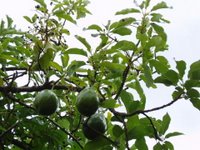
Text and photo © Isabelle Prondzynski
xxxxxxxxxxxxxxxxxxxxxxxxxxxxx
Avocado (Persea americana)
Exotic, native to the tropical Americas
A densely leafy, evergreen tree that grows to 10m or higher, widely planted at altitudes up to 2,200 m above sea level.
Bark : grey to dark brown, rough and fissured with age.
Leaves : Large; alternate; up to 20 cm long; midrib and veins prominent; glossy dark-green above; young leaves pinkish, turning bright green.
Flowers : In large terminal heads; small; abundant; pale yellow; only one in 5,000 flowers produces fruit.
Fruit : Large; round to pear-shaped; central seed surrounded by a thick layer of yellow-green flesh.
Uses : The fruit is edible, rich in fat, protein and vitamins. Its oil is used in cosmetics; dry leaves serve as fodder. The green leaves, bark and stones from the fruit are all toxic to browsing stock.
Najma Dharani, Field Guide to Common Trees and Shrubs of East Africa,
Cape Town 2002.
xxxxxxxxxxxxxxxxxxxxxxxxxxxxx
Varieties of avocado
Some popular varieties of avocado are described here :
http://www.avocado.org/about/varieties.php
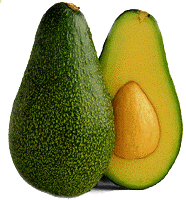
http://www.kenyaweb.com/horticulture/fuerte.gif
xxxxxxxxxxxxxxxxxxxxxxxxxxxxx
Avocado Receives "R" Rating
If a motion picture were produced on the history of the avocado, the film might have the dubious distinction of receiving an "R" rating for "mature audiences." The opening scene might feature a group of actors dressed like Aztecs with one pointing to a tree and exclaiming, "ahuacuatl!" Ahuacuatl is the Aztec word for testicle tree.
No doubt, the name arose because of the way the fruit of the tree hung in pairs reminding those ancient people of human male anatomy. The film might also have a scene showing the young Aztec maidens confined indoors while this erotic fruit with aphrodisiac qualities was being harvested.
Over many centuries the avocado has maintained its reputation as an aphrodisiac. During the 1920s a promotional advertising campaign was launched in the United States to deny that the avocado had aphrodisiac powers. The intent of the advertising agency was to convince people of the aphrodisiac quality by denying it. The campaign succeeded. Fortunately, in today's world the avocado has overcome its controversial past and receives a "G" rating for all ages to enjoy.
The avocado or avocado pear, Persea Americana, is native to Mexico, Central America, and South America. The earliest record of its existence was an archaeological dig in Peru that uncovered avocado seeds buried with a mummy and dated back to the 8th Century BCE. One theory was that these early people wanted the seeds buried with them because their aphrodisiac qualities might be useful in the afterlife.
Our currently popular avocado recipe, guacamole, may have originated in the pre-Columbian era. The Aztec ahuaca-mulli, avocado sauce, was prepared by mashing avocados and sometimes adding tomatoes and onions and, perhaps, coriander.
http://www.vegparadise.com/highestperch38.html

http://www.avocado.org/images/recipes/inset.jpg
.................................................................................
Avocado recipes
Including the famous guacamole !
:::::::::::::::::::::::::::::::::::::::::::::::::::::::::::::::::::::::::::::::::::::::::::::::::::::

Avocado blossoms
kigo for short rains
*****************************
Worldwide use
India
juice at the lip-
the kid chases the fly
coming again and again
A.Thiagarajan, India, 2006
rotten or hard
avocado in summer
seldom buttery
Aju Mukhopadhyay, India, 2006
:::::::::::::::::::::::::::::::::::::::::::::::::::::::::::::::::::::::::::::::::::::::::::::::::::::
North America
slices of avacado
spread a smile on her lips --
the local sushi roll
"chibi" (pen-name for Dennis M. Holmes)
*****************************
Things found on the way
The avocado tree (Persea americana), when grown by a hobby gardener is normally grown from seeds removed from ripened fruit. There are two acceptable methods of doing this, either by sprouting the seed in water or by actually planting the seed in soil.
Many people start avocado trees as novelty house plants by piercing the seed with its pointed end up, partially through with toothpicks on three or four sides to hold it on the top of a jar or vase partly with water and few pieces of charcoal (to keep the water sweet) just covering the base. In 2 to 6 weeks, when roots and leaves are well formed the plant is set in potting soil. Unless they're moved into soil within a few weeks or months after germination, they'll begin to deteriorate.
They are also easily sprouted in a well-drained 4- or 5-inch pot of porous, fertile soil. The top of the seed should just barely peek above the surface of the soil. If the soil is kept fairly moist and the temperature is between 60 and 70 degrees, the seed will begin to sprout and a pretty, leafy plant will develop.
Read more here :
http://www.thegardenhelper.com/avocado.html
*****************************
HAIKU
avocado tree --
the dog and I stare in vain
at its ripe fruit
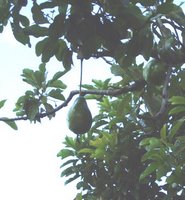
Haiku and photo © Isabelle Prondzynski
xxxxxxxxxxxxxxxxxxxxxxxxxxxxx
happy looking child
eats fleshy avocado --
no hunger at last
Cyprian Awino (Bamboochas)
Prize winner at the Bahati Ginkoo, Nairobi, 27 May 2006
幸せな 子 アボガド食べる 飢えは無し
shiawase na ko abogado taberu ue wa nashi
(Tr. Nakamura Sakuo)
xxxxxxxxxxxxxxxxxxxxxxxxxxxxx

Photo Patrick Wafula
avocados are back --
trucks overloaded with them
fruit sellers scramble
Catherine Njeri (Bamboochas)
xxxxxxxxxxxxxxxxxxxxxxxxxxxxx
August heat --
another avocado
on the ground
SUE
http://haiku.cc.ehime-u.ac.jp/shiki.archive/0009/0085.html
xxxxxxxxxxxxxxxxxxxxxxxxxxxxx
avocado
sprinkled with lime -
a sip of white wine ...
bob richardson
http://tinywords.com/haiku/2004/07/09/?comments=all
:::::::::::::::::::::::::::::::::::::::::::::::::::::::::::::::::::::::::::::::::::::::::::::::::::::
a pale shoot sprouts
from an avacado seed-
broken flower pot
Andrew Otinga, Kenya
Ocotber 2010
:::::::::::::::::::::::::::::::::::::::::::::::::::::::::::::::::::::::::::::::::::::::::::::::::::::
Some Avocado Haiku from the Nairobi Haiku Clubs
no ghee for bread--
green fleshy avocado
is sweet every morning
happy fatty girl
peels fleshy avocado
ready to bite it
my avocado
is oval shaped green fleshy--
I salivate
Cyprian Awino

Photo Patrick Wafula
a happy fatty man
selling avocados --
booming business
Philip Kaseko

Photo Patrick Wafula
happy looking child
eats fleshy avocado --
no hunger at last
~ Cyprian Awino (Bamboochas)
avocados are back--
trucks overloaded with them
fruit sellers scramble
~ Catherine Njeri Maina (Bamboocha)
a customer gently
touches an avocado --
how much is it?
~ Lameck Odhiambo (Bamboocha)
Baba Jimmy
buys an avocado and happily
peels it for his son
~ Fan (Falcon)
overripe avocados
under the big green tree --
rural dogs feast
~ Bonface (Falcon)
avocado seeds --
farmers busy in nurseries
for better plantations
~ Jelida Kerubo (Peacock)
a piece of avocado
on a man's moustache--
after lunch
guavas sitting
side by side with avocados --
the market stalls
~ Patrick Wafula (Patron, Bamboochas)
:::::::::::::::::::::::::::::::::::::::::::::::::::::::::::::::::::::::::::::::::::::::::::::::::::::
Read more Avocado Haiku from the Kenya Haiku Clubs HERE !
*****************************
Related words
*****
[ . BACK to WORLDKIGO . TOP . ]
:::::::::::::::::::::::::::::::::::::::::::::::::::::::::::::::::::::::::::::::::::::::::::::::::::::
1/07/2005
Ageing in Kenya
:::::::::::::::::::::::::::::::::::::::::::::::::::::::::::::::::::::::::::::::::::::::::::::::::::::
Ageing
***** Location: Kenya
***** Season: Non-seasonal Topic
***** Category: Humanity
*****************************
Explanation
grandfather, grandmother
Ageing in Kenya implies growing in status from age group to successive age group. From childhood to initiation and adulthood... From adulthood to marriage and parenthood... With marriage come certain rights and responsibilities.
With parenthood comes a new name since, traditionally, Kenyans call themselves “father of so-and-so” or “mother of so-and-so” rather than using their own names. A Kenyan parent is eligible to be an elder in the community, the church, and other institutions. As their children grow, Kenyan parents may relax a bit more and allow the children to carry out some of the family chores.
Grandparents are highly respected and cared for by the younger generations. Even today, their story-telling skills are often sought, and they are frequently surrounded by groups of small children enjoying their company.
Grandma Nelly enjoying the afternoon with her neighbours’ children
All this is obviously a gross generalisation, and the many exceptions may totally disprove the “rules”! Everything is not the same for women and men, for urban and rural dwellers, for one ethnic group and another, for married people versus single parents versus single people of the same age group, etc.
Looking at old age in Kenya, the highly respected elderly citizens, who have survived beyond the average life expectancy of about 55 years, do not have it easy. Medical services may be far away, and too expensive for them. Public transport makes few allowances for citizens of reduced mobility -- but the kindness of friends and strangers often makes up for this. The elderly may suffer from missing teeth and poor eyesight and may need special meals cooked for them. If living alone, they will depend on the support of others for their tougher chores, such as fetching water and cultivating the fields. With urbanisation, grandparents living in the rural area often find themselves bringing up their grandchildren, whose parents are busy struggling for a living in the city.
But there are some opportunities that do not stop with old age. Thus, Kimani Ng’ang’a Maruge became famous throughout the world when he took up the new opportunity of free primary education and went back to school at the age of 84, studying together with some of his grandchildren! He was invited to speak before the United Nations General Assembly and has become a role model for elderly people in many countries.
Text and photos © Isabelle Prondzynski
*****************************
Worldwide use
Japan
Respect for the Aged Day, Keiroo no Hi
*****************************
Things found on the way
*****************************
HAIKU
The haiku below were written as part of the
Shiki Kukai of March 2008 :
http://www.haikuworld.org/kukai/current.html
They were appreciated and discussed by the Haiku Clubs of Nairobi at their Arboretum Kukai of 29 March 2008.
Discussion of haiku on ageing at the Arboretum Kukai
my grandfather --
using less and less
of his cane
~ Abraham Muuo
my grandmother
looking at me closely --
the frown on her face
~ Anne Wairimu
sunny evening --
my grandmother talking
to herself
~ Solomon Kilelu
breezy evening --
my grandmother
trembles
~ Wandera David
Medical chit for elderly ladies’ visits to the dispensary
my grandmother
brushing a toothless mouth--
ageing
~ Joseph Kilunda
my grandfather
holding onto my hand --
a slow walk
~ Onesmus
my grandfather
chewing soft vegetables --
his toothless mouth
~ John Mwangi
grey beads swing
an old man rides a bike
across a pine road
~ hussein haji
my grandmother
struggling to chew meat --
lunchtime
~ Martin Kamau
my grandfather
searching for his specs --
grey eyes
~ Fatuma Katana
Ever active in community affairs
my grandmother --
cap tightly covering
her bald head
~ Bilha Wanjiku
my mother
looking for dye --
more grey hair
~ Irene Muthengi
my grandmother
searching for tobacco --
a new pipe
~ Lucy Nyambura
*****************************
Related words
***** Bukusu Initiation / Circumcision
***** Arboretum Kukai of the Haiku Clubs of Nairobi
*****************************
THE KENYA SAIJIKI
Back to the Worldkigo Index







